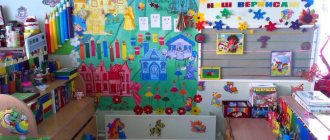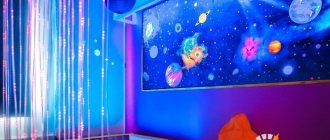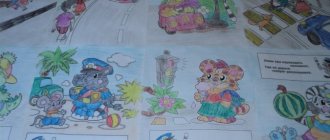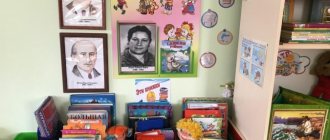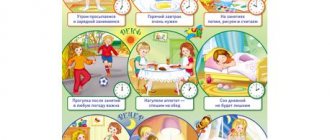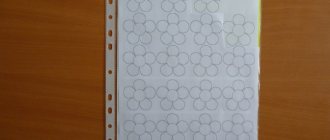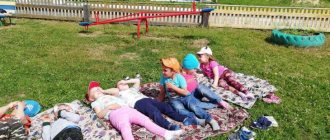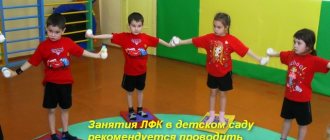You should consider the conditions for placing a music corner:
- 1. Availability of music corner equipment for children
- 2. Variety of music corner equipment
- 3. Taking into account the age characteristics of children when creating a music corner
- 4. Aesthetic design of the music corner and its equipment
Music corner equipment includes:
- • Toys, illustrations, fake musical instruments (for creating play situations in which children imagine themselves as musicians)
- • Children's musical instruments and toys for playing music:
- piano, metallophone, accordion, etc.)
- with a fixed melody (organs, organs)
- with one fixed sound (pipes)
- noise (tambourines, rattles, drums, maracas, etc.)
- • Musical and didactic games and aids (Note lotto, stave, musical ladder, games appropriate for the age and individual characteristics of children)
- • Audio and video recordings.
Musical development should not only take place in the classroom. It is necessary that the group has a variety of musical instruments, a variety of musical games and aids, and that they be properly used, taking into account the age characteristics of the children:
JUNIOR GROUPS
Vanka-Vstanka toy
Musical “singing” or “dancing” toys (cockerel, cat, bunny, etc.)
Musical instruments with a fixed sound - organs, organs
Noise instruments: rattles, bells, tambourine, drum
Unvoiced fake musical instruments (accordions, pipes, balalaikas, etc.)
Attributes for musical outdoor games
Flags, plumes, scarves, bright ribbons with rings, rattles, autumn leaves, snowflakes for children's dance creativity (replenished as needed)
Table screen with glove toys
Tape recorder and set of software audio recordings
Musical pictures for songs, which can be made on a cube, in the form of an album, or individual colorful illustrations.
MIDDLE GROUP
It is advisable to leave manuals, attributes and musical instruments from the younger group and add:
Glockenspiel
Noise instruments for children's orchestra
Books “Our Songs” (each book illustrates a song familiar to children)
Flannelograph or magnetic board
Musical and didactic games: “Musical Instruments”, “Sounding Palms”, “Rhythmic Sticks”, etc.
Attributes for outdoor musical games: “Cat and Kittens”, “Bunny”, “Hares and Bear”, “Pilots”, etc.
Musical ladders (three-stage, on which there are small and large birds or a small and large nesting doll)
Ribbons, colored scarves, plumes, etc. (attributes for dance improvisations)
Table screen and set of toys
Tape recorder and set of software audio recordings
SENIOR GROUP
In addition to the equipment of the middle group music corner, the following is used:
Rattles, tambourines, drums, triangles
Musical toys-instruments with chromatic and diatonic sound (metallophone, piano, button accordion, accordion, flute)
Illustrations on the topic: “Seasons”
Homemade musical toys (Children will be happy to take part in making instruments for a noise orchestra)
Musical and didactic games: “Learn a song by two sounds”, “Jingle bells”, “Musical ladder”, “Rhythmic lotto”, etc.
Attributes for outdoor games
Children's drawings for songs and familiar pieces of music
Table screen and screen according to children's height
Musical ladders five-step and seven-step
Attributes for children's dance creativity: elements of costumes for familiar folk dances
PREPARATORY GROUP
In addition to the material used in the senior group, the following is added:
Musical instruments: maracas, tambourines, harp, children's piano, metallophone, bells, triangles, flutes, drums.
Portraits of composers
Album folders: “We are drawing a song” with children’s drawings in which they reflect emotions and feelings about the pieces of music they listened to and their favorite songs
Manual “Emotions” (cards depicting faces with different emotional moods) for determining the nature of the melody when listening to music
Visual aids: “Symphony orchestra”, “Folk instruments”
Homemade instruments for a noise orchestra
MAGAZINE Preschooler.RF
Implementation of the Federal State Educational Standard in a kindergarten Recommendation for teachers of preschool institutions“Creation of a creative musical zone in the light of fulfilling the requirements of the Federal State Educational Standard”
EDUCATION LAW: Article 48. Teaching staff are obliged to: develop students' cognitive activity, independence, initiative, and creative abilities.
FEDERAL STATE EDUCATIONAL STANDARD OF PRESCHOOL EDUCATION:
I. GENERAL PROVISIONS:
2.4. The program is aimed at:
creating conditions for the child’s development that open up opportunities for his positive socialization, his personal development, the development of initiative and creative abilities based on cooperation with adults and peers and age-appropriate activities; to create a developing educational environment, which is a system of conditions for the socialization and individualization of children.
II. REQUIREMENTS FOR THE STRUCTURE OF THE EDUCATIONAL PROGRAM OF PRESCHOOL EDUCATION AND ITS SCOPE:
2.6 Program content:
Artistic and aesthetic development presupposes the development of prerequisites for the value-semantic perception and understanding of works of art (verbal, musical, visual), the natural world; the formation of an aesthetic attitude towards the surrounding world; formation of elementary ideas about types of art; perception of music, fiction, folklore; stimulating empathy for characters in works of art; implementation of independent creative activities of children (visual, constructive-model, musical, etc.).
Recommendations:
Creating a creative zone in a group is necessary for the development of the musical and creative abilities of a preschooler. This is an integral part of the entire pedagogical process, which is very important for nurturing aesthetic, cultural and moral qualities in a child, as well as for identifying and developing his creative and musical abilities.
Where to start creating such a creative zone?
I Study the recommendations for teachers on organizing and designing a music corner in a group.
II Together with the music director, select equipment
by sections that correspond to this age group:
2.1. Listening:
-Purchase portraits of famous Russian and foreign (including modern composers (M. Glinka, P. Tchaikovsky, D. Kabalevsky, A. Mozart, L. Beethoven, I. Bach, Krasev); -Replenish the music library on listening and perceiving music ( classical, children's, thematic and modern musical works) -Purchase DVDs with educational information about art -Select illustrations of musical instruments, sheet music, pictures of animals singing, dancing or playing musical instruments.
2.2.Playing children's musical instruments:
-Fake musical instruments - toys (made by teachers, together with children) - these are not voiced flat musical instruments made of thick cardboard or thin plywood, which are needed to create a play situation in which children, fantasizing, imagine themselves as musicians (piano, accordion , balalaika); — Material for creative role-playing games are soft toys, soft musical toys, tumbler dolls, figurative musical singing or dancing toys (dog, cat, cockerel, bunny); -Children's musical toys and instruments for creative music-making: children's piano, accordion, a metallophone is added from the middle group; -Sounded toys: (musical hammer, barrel organs, guitars, rattles, musical tops) Children examine them, try to extract individual sounds or a fixed melody from them; -Noise instruments: tambourines, rattles, drums, maracas, small and large bells, bells, spoons.
2.3 Singing and singing along:
-Keep a notebook for recording songs, poems, nursery rhymes learned in music classes; — Purchase audio recordings of the pros and cons of the song material being learned.
2.4 Didactic games:
- “Sun or rain” (for distinguishing the nature of music - “Quiet-loud” (for distinguishing dynamics) - “Guess what I’m playing” (for the development of timbre and pitch hearing) - “Rhythmic nesting dolls” (for the development of rhythmic hearing)
III Create a folder with theoretical material:
3.1 Consultations for educators: 3.2 Consultations for parents: 3.3 Scenarios for musical matinees held in a group.
When designing a musical and creative area, you need to remember the age and individual capabilities of children. So, for children 3-5 years old, it is better to build the design on a plot basis, and for older children - on a didactic basis. The musical object environment must correspond to the eye, the actions of the hand, and the growth of the child. The music corner should have a cabinet, shelves for musical aids, a table, and chairs for educational games. The aids of the developing environment are of good quality, aesthetically pleasing, attractive, easy to use, and evoke a desire to act with them. There should be carpets and soft ottomans on the floor. This creates comfort and promotes concentration. It is better to put a DVD player in the corner, with which children can listen to music, various cartoons, as well as melodies that promote psychological relaxation and mental relaxation. Usually, stands are hung on the walls of the music corner. Lyrics of songs, poems, ditties, photographs of children's performances, composers, colorful posters, pictures of musical instruments are attached to them. The music corner can be designed very interestingly and brightly - in the form of a stage podium, on the steps of which the necessary aids for musical education are located, also in the form of a pyramid, in younger groups - on various characters sewn from fabric, these can be Parsley, a matryoshka doll, a snowman. A creatively designed music corner will not only help you plunge into the world of music and expand your understanding of it, but will also develop children’s imagination, activate the emotional sphere, thinking, and speech. The music corner can be designed together with other corners, for example, with speech or educational ones. An interesting design option is to combine music and theater areas. I propose to place the following types of theaters in the music corner: 1. Picture theater (Flannelograph). (How to make) Cut out fairy tale characters from cardboard, and glue pieces of flannel on the back side; such figures will stick perfectly to plywood covered with flannel. With the help of visual accompaniment of pictures and toys, children learn to follow the actions of characters in short poems, nursery rhymes, and fairy tales. 2. Finger theater (a doll can be made from cut-off gloves, eyes, ears, and pigtails can be attached). Games with finger puppets will help your child learn to control the movements of his own fingers. 3. Table theater (Russian folk tales) In order for children to constantly maintain interest in independent musical activities, it is necessary to update the manuals in the music and theater area 1-2 times a month and introduce new equipment.
| Next > |

